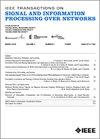基于admm的图上二次正则化分布最优传输方法
IF 3
3区 计算机科学
Q2 ENGINEERING, ELECTRICAL & ELECTRONIC
IEEE Transactions on Signal and Information Processing over Networks
Pub Date : 2025-07-10
DOI:10.1109/TSIPN.2025.3587399
引用次数: 0
摘要
图上的最优传输侧重于在考虑图的结构的同时,找到将资源从一个分布转移到另一个分布的最有效方法。本文介绍了一种新的分布式算法,它解决了有向强连通图上的最优传输问题,而不是以往的方法局限于二部图。该算法结合了二次正则化,并使用交替方向乘法器(ADMM)保证收敛性。值得注意的是,它不仅证明了二次正则化的收敛性,而且在没有二次正则化的情况下也证明了收敛性,而早期的工作需要严格的凸目标函数。在这种方法中,节点被视为通过本地交互协作以优化总运输成本的代理,仅依赖于来自其邻居的信息。通过数值实验,我们展示了二次正则化对不同图结构下的收敛性和解稀疏性的影响。此外,我们还提供了一个实际示例,通过其适应图中拓扑变化的能力来突出算法的鲁棒性。本文章由计算机程序翻译,如有差异,请以英文原文为准。
An ADMM-Based Approach to Quadratically-Regularized Distributed Optimal Transport on Graphs
Optimal transport on a graph focuses on finding the most efficient way to transfer resources from one distribution to another while considering the graph’s structure. This paper introduces a new distributed algorithm that solves the optimal transport problem on directed, strongly connected graphs, unlike previous approaches which were limited to bipartite graphs. Our algorithm incorporates quadratic regularization and guarantees convergence using the Alternating Direction Method of Multipliers (ADMM). Notably, it proves convergence not only with quadratic regularization but also in cases without it, whereas earlier works required strictly convex objective functions. In this approach, nodes are treated as agents that collaborate through local interactions to optimize the total transportation cost, relying only on information from their neighbors. Through numerical experiments, we show how quadratic regularization affects both convergence behavior and solution sparsity under different graph structures. Additionally, we provide a practical example that highlights the algorithm robustness through its ability to adjust to topological changes in the graph.
求助全文
通过发布文献求助,成功后即可免费获取论文全文。
去求助
来源期刊

IEEE Transactions on Signal and Information Processing over Networks
Computer Science-Computer Networks and Communications
CiteScore
5.80
自引率
12.50%
发文量
56
期刊介绍:
The IEEE Transactions on Signal and Information Processing over Networks publishes high-quality papers that extend the classical notions of processing of signals defined over vector spaces (e.g. time and space) to processing of signals and information (data) defined over networks, potentially dynamically varying. In signal processing over networks, the topology of the network may define structural relationships in the data, or may constrain processing of the data. Topics include distributed algorithms for filtering, detection, estimation, adaptation and learning, model selection, data fusion, and diffusion or evolution of information over such networks, and applications of distributed signal processing.
 求助内容:
求助内容: 应助结果提醒方式:
应助结果提醒方式:


